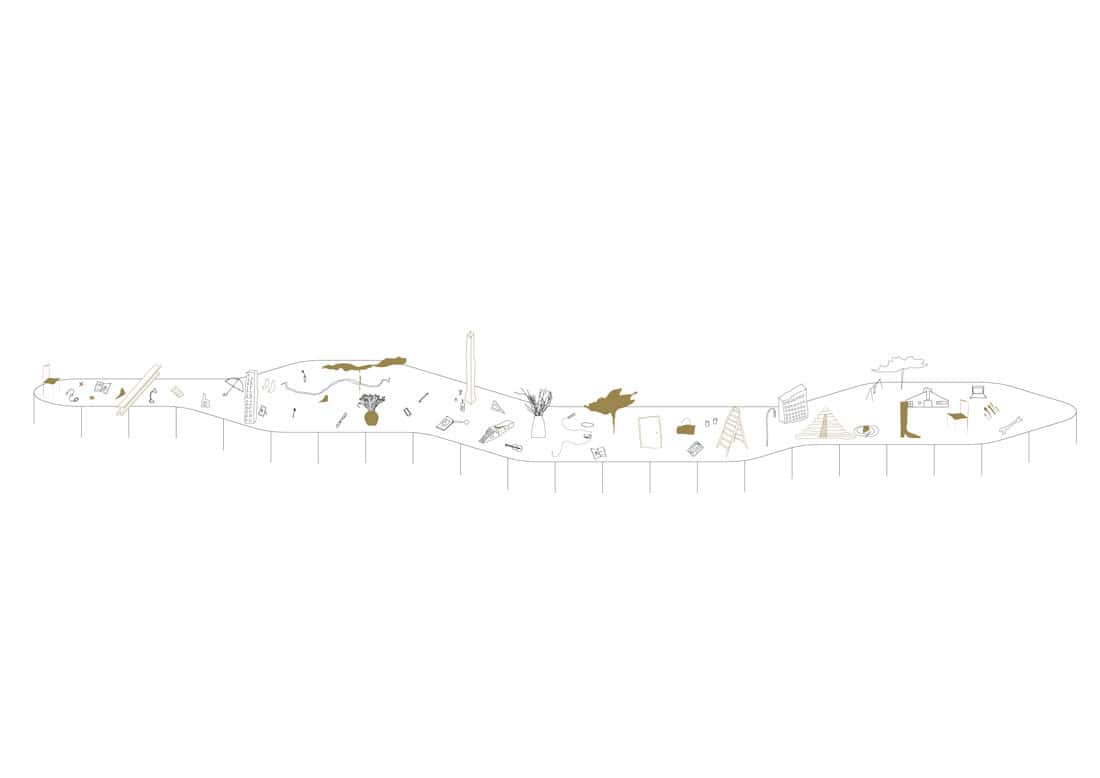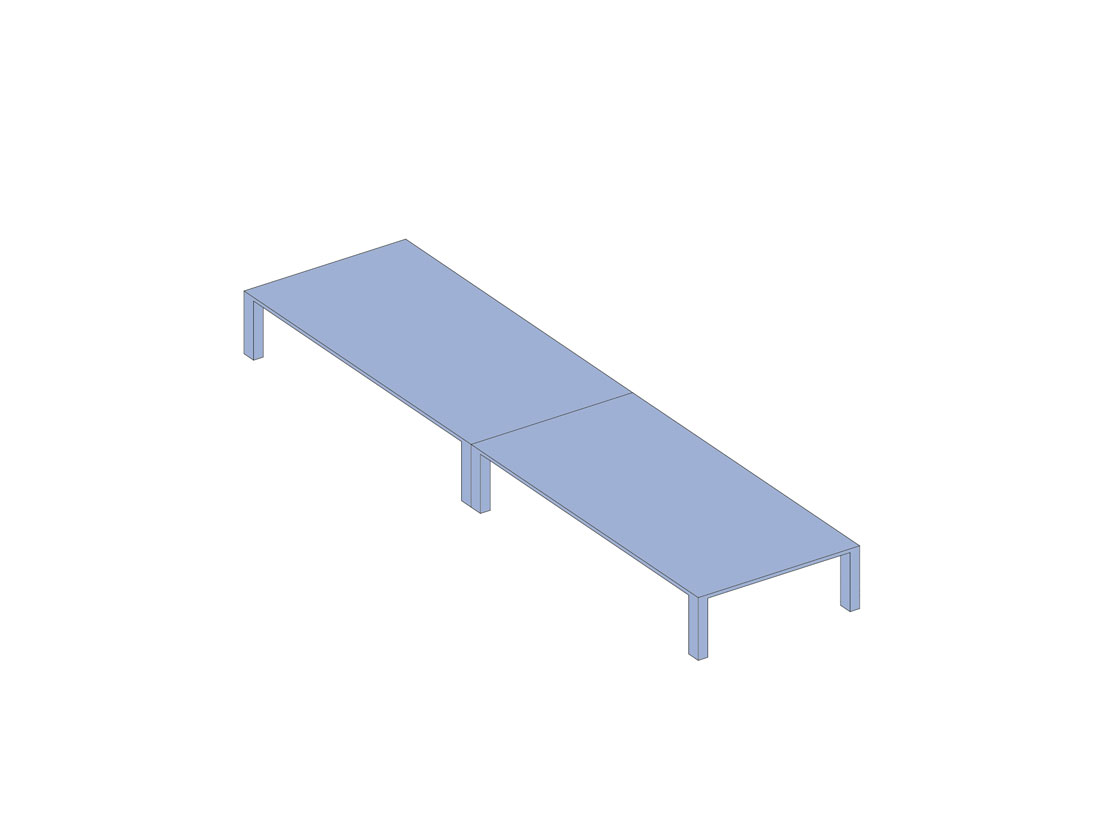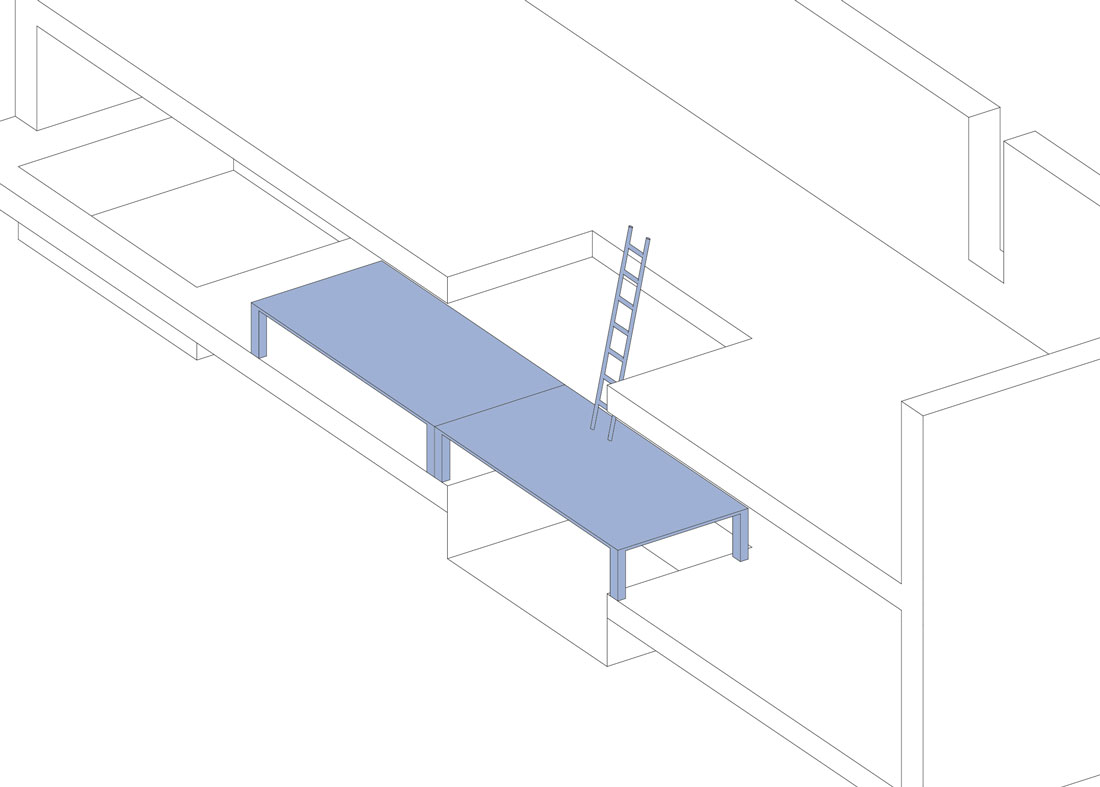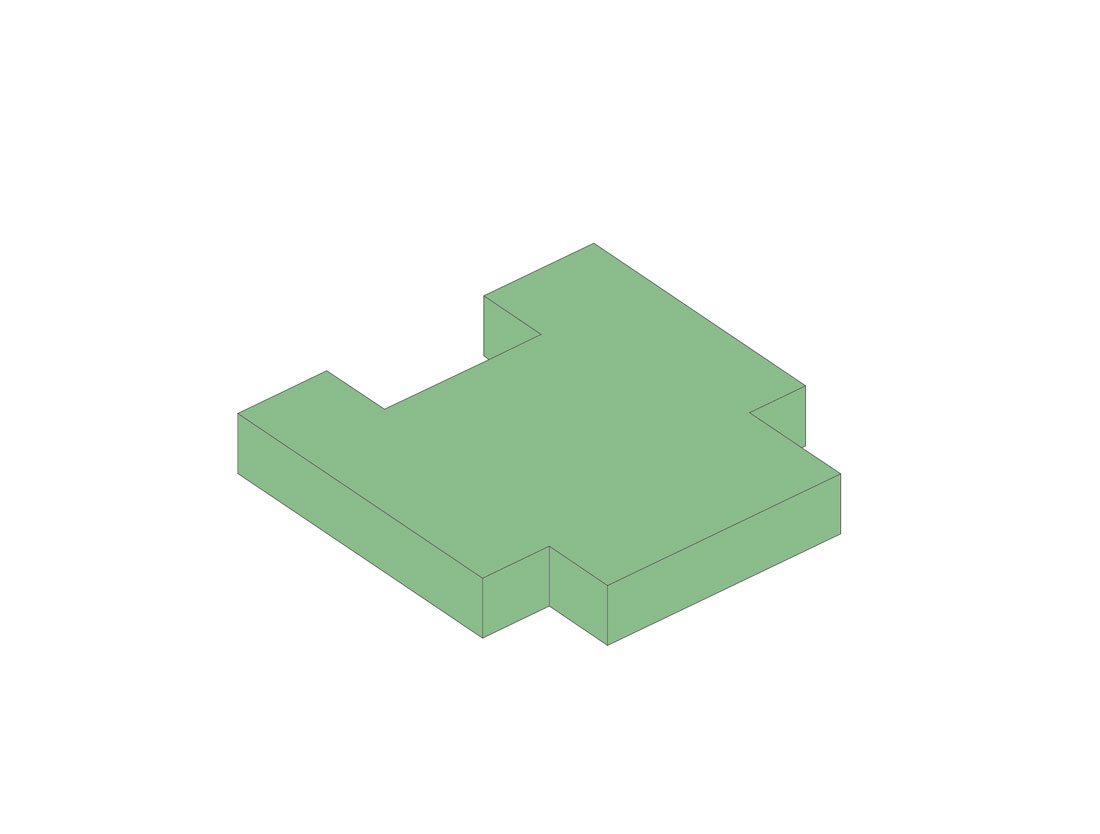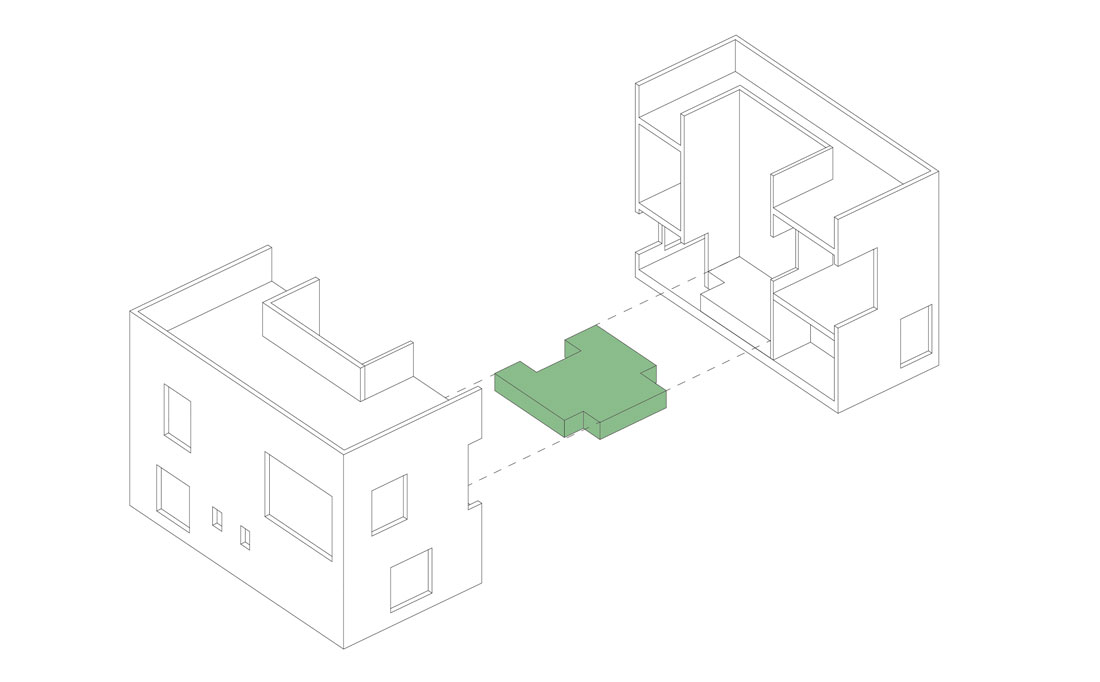table (ta•ble)
a piece of furniture consisting of a smooth flat slab fixed on legs
Mirriam-Webster Dictionary
There is no more ubiquitous piece of furniture in architectural culture than the table. Practically, tables perform as objects of convenience. Conventionally, they serve to establish scale for the plan and represent the function of the space: coffee table, dining table, drafting table, occasional table, offering table, operating table, side table, work table. Historically, they have inspired integrated-tables (floors and walls that absorb tables), macro-tables (buildings that look like tables), and micro-architectures (tables that look like buildings).[1] Occasionally, they disappear as one thing, and reappear as something else.
I can think of eight tables in three recent projects that exceed themselves in this last way: Hideyuki Nakayama’s 004 House (2006), Junya Ishigami’s Tables for a Restaurant (2008), and Go Hasegawa’s Sakuradai House (2006). Each table exhibits the characteristics of neutrality and minimal form. Each exaggerates a flat rectangular surface, adding a degree of excess or redundancy. And each goes beyond mere utilization and materialization to assert a super-cultural surprise. All at once, each becomes a thing that seems to name the table, just as it names something else.[2]
To write about such tables from the west is no easy task. From here, criticism usually entails stripping away noise to uncover the significance of something. However, these Japanese projects are already so succinct, so flatly present, that there is little left to subtract. As Roland Barthes writes in Empire of Signs, “there is nothing there to read.”[3] The labor of criticism here, then, is to add: to expound on how and why something does what it does. What follows is an attempt to elaborate an answer to a straightforward question: what is that other thing, that super thing, these tables do?
Long table in Hideyuki Nakayama’s 004 House in Matsumoto, Nagano, Japan
Axonometric section of the table in Hideyuki Nakayama’s 004 House in Matsumoto, Nagano, Japan
Magic Mat
The long table in Hideyuki Nakayama’s 004 House in Matsumoto, Nagano, Japan, offers an excellent opening into the question, because it hosts un-table-like functions. The table is expediently constructed from two identical tables (with flat tops and rectilinear legs, the most generic of table constructions[4]) crudely bolted to each other and into the floor. Centered like a fashion runway on the first floor, or an enlarged diving board, the table proportionally duplicates the tiny house’s plan. It is less something that occupies the house than something the house is built around. It is almost as though the table wears the house just as it constructs the house.
The tabletop organizes domestic inhabitation along two axes. Table one (west) works horizontally, serving as a normative dining and work table—one eats and works at the table. Drawings and film show it sprinkled with domestic objects—tableware, potted plants, laptops, lamps, vases, and place mats—and surrounded by four chairs at one end. Encircled with circulation space, it obliges sedentary activity. Table two (east) activates vertically, producing an unlikely bridge between a second-floor bedroom and a sunken study—here one resides either above or below the table. Like scaffolding on a construction site, it spans a large hole that extends beyond its southern edge. There is another opening above it. Also encircled with circulation space, though this time in section, the table becomes circulation as it stages a vertical movement through the double-height void. It is an expedient device for transportation impossible to sit at.
Significantly, this device is not always drawn as a conventional piece of furniture. In one set of sections published in Japan Architect, the table disappears. [5] Less object than a line, it emerges like Aladdin’s magic carpet: a mat levitating between two floors with a figure standing on it. This two-dimensional delineation contrasts with the three-dimensional depictions of all other furniture (chair, sink, toilet, kitchen cabinetry, closet) in the same drawing. Why is the heaviest piece of furniture represented as the lightest? In other published drawings, the table is drawn with thickness, but a chair sits on top of it, while interior photographs show a ladder propped up on it. All of these representations accentuate the table as something in excess of merely floor or furniture; they give emphasis to a removal of the table’s functional specificity in its eastward progression.
This removal is literally enabled by the rearrangement of space above and below the table. For example, the “under the table” space that typically belongs between two parallel planes—the floor and table underside—is here transferred into the study below, as the expected floor drops out into the void increasing the rooms floor to ceiling height so that adults can now play under the table. Without a floor to accommodate placement of chairs, the table loses its primary reason for existence. Through subtraction and displacement, the table is stripped of its table-ness. As one traditional table function (sitting at) is replaced by others (climbing on, standing on, hiding under), table talk fades into table walk.
Once liberated from its table-ness, the tabletop can perform other functions. In addition to providing a ceiling to the sunken study, it visually screens the second-floor bedroom from the study. It acts as a landing in an exploded stair sequence that progresses from a concrete ledge in the study, to cedar board stair object, urethane resin painted floor, more cedar board steps, the tabletop, wooden ladder, to the rattan lined second floor. It collaborates with a double height void to yield continuous space around, over, and under. In all these ways, the tabletop is liberated from object to architecture.
In Nakayama’s example, the table’s quality leads to a grasping of it as an event rather than an object, an occurrence that entails inhabitants putting back together a shattered stair sequence from ad hoc furniture parts: stepstool, chair, table, ladder. Like a fixed elevator caught between two floors, the table provides a center of gravity, but without delimited prescriptions: inhabitants need to learn how to use the table; how to get to the table. In this way, the table deterritorializes a fixed architectural element—the staircase—into a novel assemblage of elements perpetually subject to reconfiguration. It conjures the super-cultural idea of architecture lifting up and setting down inhabitants without machinery: the fiction of a magic mat.
Junya Ishigami’s Tables for a Restaurant
Axonometric view of Junya Ishigami’s Tables for a Restaurant
Green Cloud
Junya Ishigami’s Tables for a Restaurant advances another flatly fictional possibility. Inside a 50 m2 room, five differently sized tables are arranged in two rows with circulation space between them. Their surfaces horizontally divide the interior into five private dining areas—five “tables for two”—in lieu of vertical walls, yielding an alignment that is both confined and open. An imaginary rectangle, offset from the restaurant’s interior walls, determines and limits the arrangement. Tables are held in place by the circulation that surrounds them; they absorb leftover space to expand horizontally. Tabletops act, as Ishigami puts it, as “gentle separators of the space” and “a space in its own right.”[6]
The tables, which are too large for the program despite relatively small dimensions (from 2 x 2 m to 2 x 0.6 m), operate as a set. Relationships between seats, sightlines, and plants unify the five into a single, yet abstruse, composition. Pairs of seats huddle at table extremities—at a corner, side-by-side along an edge, directly opposite one another—to allow intimate propinquity. Potted plants, positioned on surplus surface areas, provide garden-like scenery that envelops diners. Seating positions alternate in plan to provide physical distance between pairs of diners throughout the room, and eye-level foliage obscures one table from another while serving as petite shakkei (borrowed scenery) for other tables. Each table plays a role in a system entirely established by dependent interactions. Each offers proximity and distance.
Photographs show the surreal visual effects of this coordinated effort on the interior: what is usually on the ground—potted plants—now float on a line. The table’s wafer-thin profile allows for this optical illusion. Like Ishigami’s earlier Table (2006)—a 9.5 x 2.6 x 1.1 m table unrolled from a single 3 mm thick aluminum sheet—the tables achieve their paper-like-quality through an excision of material thickness and detail. And like Table, each presents a scaleless image: tabletops—here 4.5 mm thick steel sheets finished with a 0.3 mm thick wood veneer—seamlessly fold down at ninety degrees into legs. In profile, the tables become drawings: thin black lines from one side; beige infills sans outline from the other. The overall effect diminishes the tables in perspectival depth: five tables become one; five become a single line.
This is not any kind of line. It is a ground line without mass; a horizon line that separates earth from sky; a base line from which the tables emulate their surroundings. Below the line, dark undersides, edges, and legs recede into the polished, dark grey, concrete floor. A forest of slender furniture legs (chairs and tables) conjure an imaginary earth striated with columns. Above the line, the table’s beige veneer surface disappears into the restaurant’s off-white walls and ceiling. Bulbous white pots spouting stems, sprigs, fronds, leaves, and flowers, invoke an imaginary sky populated with solid balloons and green feathers. And projected back from the line, the tabletops assume the role of backgrounds: a blank canvas; a rectangular frame from which other things can emerge.
Between 5–10 species of plants populate each tabletop—winter jasmine, flowering currant, white mustard, clover, geraniums, maidenhair to name a few species—in differently shaped pots. The loosely arranged objects, leaves, flowers, and stems, affectionately drawn by hand in green, pink, purple, orange, blue, and yellow colored pencils, are intricate figures that advance from their backgrounds. Their casual arrangements contrast with the formal table layout. Indeed, each tabletop has its own plan. Plants are set inside rectangles like elements of a still life painting: in and on the plane simultaneously. Collectively they act as spatial counterpoints to empty areas left aside for eating. They connote that the conventional use of the table occurs at a single corner, an end, a side.
The combination of table and objects yields an atmosphere with an “indistinct aesthetic”[7]: a foliated stratus opacus; a vegetal mist made of tiny volumes unified in color, shape, texture, and form; a green cloud. This allusive midriff-like figure plays the same role in the interior as the monochromatic white and grey mist in a Japanese screen print: both occlude information and allow scope for imagination.[8] Yet it achieves its effects through an extraordinary visual inversion: if the white clouds of Japanese screen prints obstruct through their blank emptiness, the green cloud in Tables for Restaurant obscures through articulated fullness. Everything else is drained.
Table at the epicenter of Go Hasegawa’s House in Sakuradai
Axonometric exploded view of Go Hasegawa’s House in Sakuradai
Suspended Room
The large table at the epicenter of Go Hasegawa’s House in Sakuradai offers a third super-cultural surprise. At just over 4 x 4 m, it fills an entire room—the central hole in a two-story donut plan—as private bedrooms encircle it at ground level and an open dining/kitchen/living space at an upper level. A double height void with a glass ceiling soars immediately above; painted plywood walls with clerestory windows define its edges. As an object, the table elides easy categorization: instead of designating a specific kind of activity, it multiplies new descriptions for rooms—“void room,” “floor space/table,” “yard-like table,” and “second living room”—even though the architectural drawings consistently label it, simply, if mysteriously, as “table.”[9]
This descriptive ambivalence can be attributed to the fact that the table holds more to a space, than to people or objects. It is, more accurately, a gigantic plain without legs: a vast birch paneled surface built like a floor. Indeed, a system of 60 x 60 mm floor joists spaced at 800 mm centers support it. Closed off by stud walls veneered in plywood, the table’s section is thick, more of the ground than the sky, lying somewhere between a raised landform, a mesa, and an earth sculpture—a distant reprise of Walter De Maria’s The Earth Room (1977). At the same time, it exhibits what artist Donald Judd once referred to as “reasonableness, usefulness and scale” as a table.[10] This reasonableness can be found in its height and in how it performs as a desk.
Desk-ness occurs at three locations: where the table meets the children’s bedrooms at two corners, and where it connects with the study on one side. Through an unlikely Venn diagram of room and table, the overlap yields a pocket of space for a chair (or two), and leads to a curious suspension of rooms on either side of it. On the one hand, surface area is subtracted from the top to allow peripheral rooms to be brought to the table. The indented shape of the tabletop accommodates the room; plywood sides, which mimic surrounding walls, complete the room. On the other hand, pairs of sliding doors extend from walls on either side of the table to inversely close off the central atrium, effectively tabling the room. Here, the table reinstates itself as a square space in plan by imposing its orthogonal shape onto its periphery.
Largely defined in relation to what is “slightly outside of it,” the table structures visual relationships at its edges and provides the possibility for an inhabitant to be in two places at once. [11] Visual opulence radiates from inward facing chairs: sightlines diffuse through rooms and atrium to outside. When seated at the table, one can select framed scenery—trees, street, neighboring houses, sky—through large, strategically positioned openings in walls and glass ceiling and along horizontal or diagonal lines. Simultaneously, the body divides at the table’s boundary. As Hasagawa describes, when seated at the table, the body is present in two kinds of space: the lower part in a chair in an intimate private room; the upper part in a “magnificent table space.”[12]
This highly programmed perimeter yields an unoccupied center: an empty middle, an external zone free from planned activities, an ambiguous space without fixed purpose.[13] Indeed, interior photographs evidence this divergence between purpose and non-purpose: embedded electrical outlets, plants, cards, pencils, papers, and toys aggregate at table corners and edges while a largely vacant middle exudes in between. In this regard, the table’s outline and size is more important than its infill: everything that falls beyond reach from a chair becomes superfluous, residual, and free. From periphery to center, tableness gradates into floorness.
Yet in all of its orchestrations and accommodations, perhaps the most intriguing thing Hasagawa’s table invokes is the idea of a suspended room; the notion that space hovers above the table. Rather than space structuring the table, the table now makes possible the space in an inversion of mimicry.
The most extraordinary thing about Nakayama’s, Ishigami’s, and Hasagawa’s tables is that all of their effects are asserted in a single form. In each project, tables disappear and reappear under different guises and relate to people, objects, and spaces in distinctive ways. In Nakayama’s 004 House, table effects are achieved through the combination of person and table. The table disappears through a denial of functional use and reappears as a free landing. In Ishigami’s Tables for a Restaurant, the tables relate to objects arranged on their surfaces. Tables disappear through their technical precision—their material reduction to a line—and reappear as the invisible scaffolding for a cloud of objects. In Hasagawa’s House in Sakuradai, the table directly relates to space: it simultaneously fills and suspends a room, all the while disappearing into the background. All of this is possible because each table has something inherently superfluous about it—a mannerist strain, as Robert Venturi would call it—which allows for contradiction, paradox, and ambiguity, and which makes its effects inherently architectural.[14]
Furthermore, the architecture of these tables lies not in their resemblance to architecture, but in what can be done with a rectangular plane parallel to the ground. In other words, the architecture is conceived through horizontality, not verticality. Like the shift from wall art to floor art in minimalist art, the tables activate floor architecture instead of wall architecture, even (or especially) as they all act in the new dimension of section. In their effects, they also leave the object behind, suggesting that the super-object is, in fact, a post-object, an object that ushers in the end of the object, along with all of its related orientations and ontologies.





